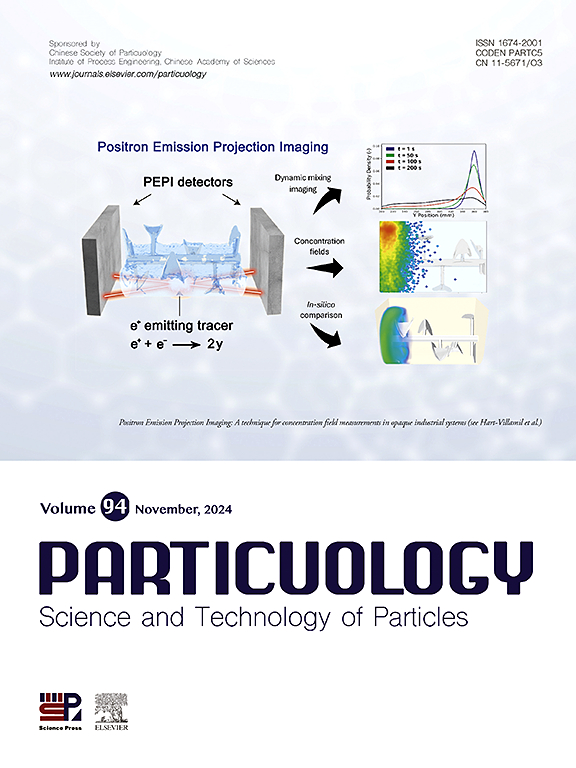Romanesco-like calcium carbonate hybrid nanoflowers via egg white lysosomal enzyme-assisted biomineralization
IF 4.1
2区 材料科学
Q2 ENGINEERING, CHEMICAL
引用次数: 0
Abstract
Bioinspired hybrid organic–inorganic nanoflowers can be significantly influenced by the inclusion of enzymes derived from cellular organelles, thus offering unique structural functions and applications. This study has introduced a novel approach using egg-white lysosomal enzymes (EWLEs) for the synthesis of Romanesco-like calcium carbonate (CaCO3) hybrid nanoflowers, marking the first use of cellular organelle enzymes in this context. Our approach leveraged the intrinsic properties of EWLEs, leading to the formation of nanoflowers composed of calcite and vaterite polymorphs via biomimetic mineralization. These hybrid nanoflowers successfully incorporated 1.0 mg of EWLE, exhibited a specific peroxidase activity of approximately 0.0198 mM min−1 mg−1 and retained over 78% of their initial activity for more than 60 days, demonstrating exceptional stability. This work challenges traditional methods by emphasizing the dynamic, biomimetic transformation of enzyme-organic hybrid systems, and offers new insights into enzyme-material interactions. This bridges the gap between biomineralization and enzyme applications and opens innovative possibilities for stabilizing enzymes, enhancing catalytic efficiency, and developing advanced biomaterials for biocatalysis.

通过蛋清溶酶体酶辅助生物矿化制备的仿罗马esco型碳酸钙杂交纳米花
生物启发的有机-无机杂交纳米花可以受到来自细胞器的酶的显著影响,从而提供独特的结构功能和应用。本研究介绍了一种利用蛋白溶酶体酶(EWLEs)合成类似罗马esco的碳酸钙(CaCO3)杂交纳米花的新方法,这标志着细胞器酶在这方面的首次使用。我们的方法利用了EWLEs的固有特性,通过仿生矿化形成了由方解石和水晶石多晶组成的纳米花。这些杂交纳米花成功地加入了1.0 mg的EWLE,表现出约0.0198 mM min - 1 mg−1的特异性过氧化物酶活性,并在60天以上保持了超过78%的初始活性,表现出优异的稳定性。这项工作通过强调酶-有机混合系统的动态、仿生转化来挑战传统方法,并为酶-材料相互作用提供了新的见解。这弥合了生物矿化和酶应用之间的差距,并为稳定酶、提高催化效率和开发用于生物催化的先进生物材料开辟了创新的可能性。
本文章由计算机程序翻译,如有差异,请以英文原文为准。
求助全文
约1分钟内获得全文
求助全文
来源期刊

Particuology
工程技术-材料科学:综合
CiteScore
6.70
自引率
2.90%
发文量
1730
审稿时长
32 days
期刊介绍:
The word ‘particuology’ was coined to parallel the discipline for the science and technology of particles.
Particuology is an interdisciplinary journal that publishes frontier research articles and critical reviews on the discovery, formulation and engineering of particulate materials, processes and systems. It especially welcomes contributions utilising advanced theoretical, modelling and measurement methods to enable the discovery and creation of new particulate materials, and the manufacturing of functional particulate-based products, such as sensors.
Papers are handled by Thematic Editors who oversee contributions from specific subject fields. These fields are classified into: Particle Synthesis and Modification; Particle Characterization and Measurement; Granular Systems and Bulk Solids Technology; Fluidization and Particle-Fluid Systems; Aerosols; and Applications of Particle Technology.
Key topics concerning the creation and processing of particulates include:
-Modelling and simulation of particle formation, collective behaviour of particles and systems for particle production over a broad spectrum of length scales
-Mining of experimental data for particle synthesis and surface properties to facilitate the creation of new materials and processes
-Particle design and preparation including controlled response and sensing functionalities in formation, delivery systems and biological systems, etc.
-Experimental and computational methods for visualization and analysis of particulate system.
These topics are broadly relevant to the production of materials, pharmaceuticals and food, and to the conversion of energy resources to fuels and protection of the environment.
 求助内容:
求助内容: 应助结果提醒方式:
应助结果提醒方式:


